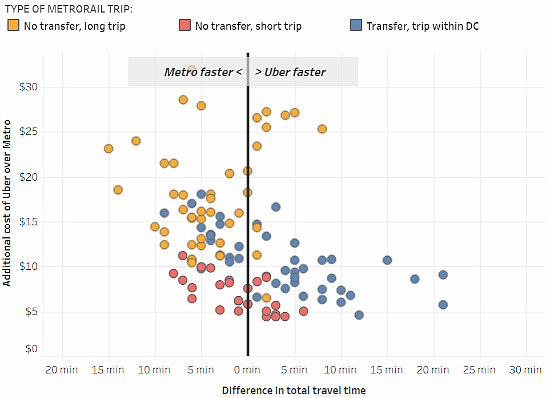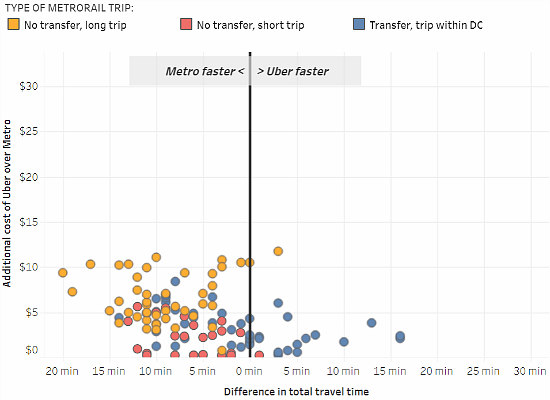With Metrorail ridership declining due to maintenance issues and unreliable service, it stands to reason that a lot more people are relying on alternative forms of transportation like ride-hailing services. But how much time does an Uber or Lyft really save you on your journey?
A new post from District, Measured seeks to answer that question with a graphic representation comparing the costs and times of various trips — both long and short trips that require no transfer between Metro lines and trips within DC that require a transfer — and an interactive tool comparing the travel times of both Metro and Uber.

Time and cost of taking Metro vs. Uber X
Based on the 114 trips studied, trips within the District that would require transferring between Metro lines are generally faster via Uber X than Metro, although those trips tend to be $5 to $15 more costly than a train fare.
For example, a commuter would save 15 minutes on a trip from Union Station to Benning Road if they used Uber X rather than Metro. There are some instances where this doesn’t hold true, though, as it is 10 minutes faster to take Metro to get from Columbia Heights to Eastern Market than to take Uber, assuming that trains are running on time and there are no service issues. For trips outside of the District that don’t require a transfer, an on-time Metro can be a better value, as the trip from Metro Center to Bethesda is 14 minutes shorter by Metro than by Uber.

Time and cost of taking Metro vs. Uber Pool
When compared to Uber Pool, the train (assuming that it is running on-time) often wins out in terms of time, as most Metrorail trips are shorter than an Uber Pool trip. However, on some trips within DC that require transfers, Uber Pool users may save up to 10 minutes and usually pay less than a $6 premium above Metro riders making the same journey.
Although not all trips are available for comparison, the interactive tool on District, Measured’s site allows you to play with the underlying assumptions of the trips studied to make them more accurately reflect particular circumstances. The default assumptions are that there is a 3-minute wait for a train with no delays on the line and a 10-minute walk to and from Metro, as well as a 5-minute wait for an Uber and an extra 5 minutes of transit time for those who opt for the Pool option.
